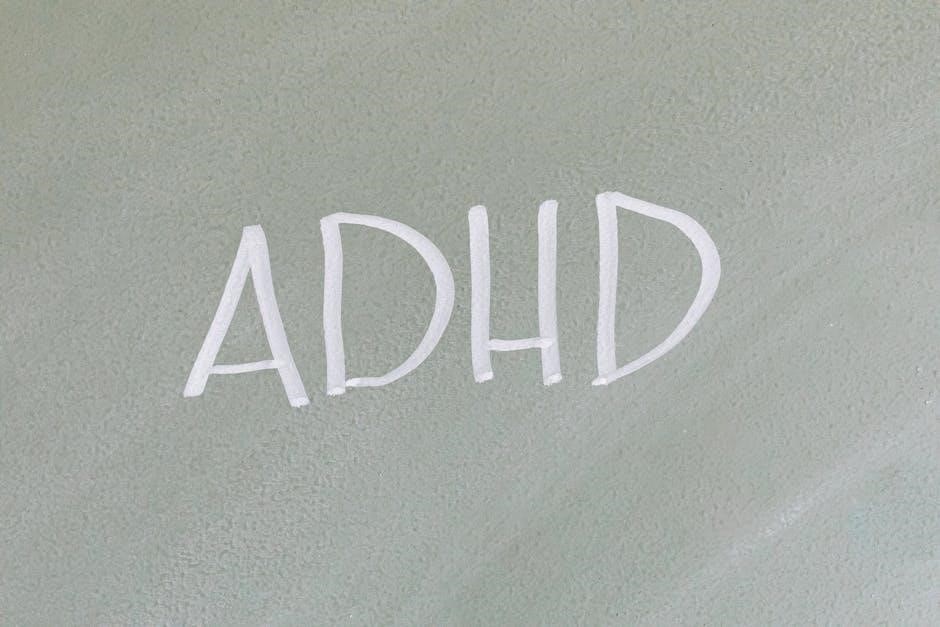Attention Deficit Hyperactivity Disorder (ADHD) PDF: A Comprehensive Guide
This comprehensive guide provides an overview of Attention Deficit Hyperactivity Disorder (ADHD)․ It outlines diagnostic criteria, symptom presentations, and relevant resources․ The guide draws upon the DSM-5 for accurate information․
Attention Deficit Hyperactivity Disorder (ADHD) is a neurodevelopmental condition․ It manifests as persistent patterns of inattention, hyperactivity, and impulsivity․ These patterns significantly interfere with an individual’s functioning and development․ The disorder is commonly diagnosed in childhood․ However, it often persists into adolescence and adulthood․

We’ll explore the three primary presentations of ADHD․ These are predominantly inattentive, predominantly hyperactive-impulsive, and combined․ It is crucial to note that there is no single test for ADHD diagnosis․ Instead, it is a clinical assessment considering behavioral patterns and developmental history․ Early recognition and intervention are key to managing ADHD effectively and improving outcomes;

Understanding ADHD Diagnostic Criteria
This section dives into the diagnostic criteria for ADHD․ We will use the DSM-5 framework․ This will ensure a clear understanding of the specific symptoms and requirements for diagnosing this neurodevelopmental disorder․
DSM-5 Diagnostic Criteria Overview
The DSM-5 provides the standardized diagnostic criteria for Attention-Deficit/Hyperactivity Disorder (ADHD)․ This framework is crucial for accurate diagnosis and appropriate treatment․ The core of the diagnosis hinges on identifying a persistent pattern of inattention and/or hyperactivity-impulsivity․ This pattern must significantly interfere with an individual’s functioning or development․

The DSM-5 outlines specific symptoms within two main categories: inattention and hyperactivity-impulsivity․ To meet the diagnostic criteria, a certain number of these symptoms must be present․ These symptoms must also have been evident before a certain age․ Furthermore, they must manifest in multiple settings (e․g․, home, school, work)․
The DSM-5 also acknowledges different presentations of ADHD․ These include predominantly inattentive, predominantly hyperactive-impulsive, and combined presentations․ Understanding these presentations is vital for tailoring interventions to address specific symptom profiles․ Finally, the DSM-5 emphasizes the importance of considering symptom severity and its impact on daily life․
Inattention Symptoms (DSM-5)
The DSM-5 outlines specific inattention symptoms that are key to diagnosing ADHD․ These symptoms must be persistent and cause significant impairment in daily functioning․ According to the DSM-5, individuals with ADHD may frequently fail to give close attention to details․ They often make careless mistakes in schoolwork or other activities․
Another common symptom is difficulty sustaining attention in tasks or play activities․ They may seem not to listen when spoken to directly․ Individuals might also struggle to follow through on instructions and fail to finish tasks․ This can include schoolwork, chores, or duties in the workplace․
Furthermore, they often have difficulty organizing tasks and activities․ They may avoid, dislike, or be reluctant to engage in tasks that require sustained mental effort․ Losing things necessary for tasks or activities is another hallmark symptom․ They can be easily distracted by extraneous stimuli and are often forgetful in daily activities․ The presence of several of these symptoms is crucial for an ADHD diagnosis․
Hyperactivity and Impulsivity Symptoms (DSM-5)
The DSM-5 outlines specific hyperactivity and impulsivity symptoms crucial for diagnosing ADHD․ These symptoms must be persistent and cause impairment․ Hyperactivity often manifests as fidgeting or squirming in seats․ Children may leave their seat in situations when remaining seated is expected․
Individuals may run about or climb in inappropriate situations․ They may also be unable to play or engage in leisure activities quietly․ Often, they seem “on the go” or act as if “driven by a motor․” Excessive talking is another common sign of hyperactivity․
Impulsivity can present as blurting out answers before questions have been completed․ They may have difficulty waiting their turn and often interrupt or intrude on others․ This intrusion can disrupt conversations or games․ Several of these symptoms must be present for an ADHD diagnosis․ The symptoms must also negatively impact social, academic, or occupational functioning․

ADHD Presentations According to DSM-5
The DSM-5 recognizes three presentations of ADHD: Predominantly Inattentive, Predominantly Hyperactive-Impulsive, and Combined․ Each presentation is defined by the prominent symptom patterns exhibited by the individual․
Predominantly Inattentive Presentation
The Predominantly Inattentive presentation of ADHD is characterized by difficulties with focus, attention to detail, and organization․ Individuals with this presentation often struggle to sustain attention during tasks or play, and may appear forgetful or easily distracted․ According to DSM-5 criteria, at least five symptoms of inattention must be present for at least six months to warrant a diagnosis in adults, while six symptoms are required for children․
They may frequently lose items, have trouble following instructions, and avoid tasks that require sustained mental effort․ These symptoms can significantly impact academic, occupational, and social functioning․ It’s essential to note that individuals with this presentation might not exhibit hyperactivity or impulsivity․ This presentation was formerly known as ADD․
It is also essential to remember that these symptoms must negatively impact academic, social, and/or occupational functioning․ It’s important to consult with a qualified healthcare professional for accurate diagnosis and appropriate management․
Predominantly Hyperactive-Impulsive Presentation
The Predominantly Hyperactive-Impulsive presentation of ADHD is defined by excessive fidgeting, difficulty remaining seated, and a tendency to talk excessively․ Individuals often struggle with impulsivity, interrupting others, and acting without thinking․ As per DSM-5 criteria, at least five symptoms of hyperactivity-impulsivity must be evident for a minimum of six months for adults, while six are needed for children to meet the criteria for diagnosis․
They may experience difficulty waiting their turn, blurting out answers, and engaging in risky behaviors․ This presentation can significantly impact academic, occupational, and social interactions․ Individuals with this presentation might not necessarily exhibit symptoms of inattention․ Hyperactivity often presents differently in adults than children, often manifesting as restlessness, fidgeting, or difficulty engaging in quiet activities․
A proper diagnosis requires a comprehensive evaluation by a healthcare professional․ Symptoms must have a direct, negative impact on social, academic, and/or occupational functioning․
Combined Presentation
The Combined Presentation of ADHD is diagnosed when an individual meets the criteria for both Inattentive and Hyperactive-Impulsive presentations․ This signifies a significant presence of symptoms from both categories․ According to the DSM-5, for a diagnosis of Combined Presentation, individuals must exhibit at least five symptoms of inattention and five symptoms of hyperactivity-impulsivity for adults, whereas six symptoms for each category is required in children․
These symptoms must be present for at least six months; The combined presentation can manifest in various ways, impacting multiple areas of life․ Individuals struggle with maintaining focus, following instructions, and organizing tasks․ Simultaneously, they may experience restlessness, impulsivity, and difficulty waiting their turn․ The combined impact can lead to challenges in academic performance, social interactions, and emotional regulation․
Accurate diagnosis and intervention are crucial for managing the challenges associated with the Combined Presentation of ADHD․ A comprehensive assessment, including behavioral observations and standardized rating scales, is necessary for proper diagnosis․

Diagnostic Process
Diagnosing ADHD involves a comprehensive evaluation․ Clinicians assess symptoms based on DSM-5 criteria․ They also consider duration, onset, impact on functioning, and the presence of symptoms across multiple settings to arrive at an accurate diagnosis․
Symptom Thresholds for Diagnosis
To meet ADHD diagnostic criteria, individuals must exhibit a specific number of symptoms․ For children, the DSM-5 requires at least six symptoms of inattention and/or hyperactivity-impulsivity․ These symptoms must have persisted for at least six months․ Additionally, the symptoms should negatively impact social, academic, or occupational activities․
Adolescents (17 years and older) and adults need to present with five or more symptoms․ It’s crucial that these symptoms are inconsistent with their developmental level․ Furthermore, clinicians must carefully evaluate the degree to which these symptoms interfere with daily life․ They also consider the individual’s overall functioning;
The symptom threshold ensures a standardized approach to diagnosis․ This helps to differentiate ADHD from typical behavior․ Careful assessment is necessary to confirm the presence of ADHD․ This is done before considering any treatment plans․
Duration and Onset Criteria
For an ADHD diagnosis, the persistence and timing of symptoms are crucial․ The DSM-5 stipulates that symptoms must have persisted for at least six months․ This duration criterion is essential to distinguish ADHD from temporary difficulties․ These difficulties could be arising from situational stressors․
Moreover, the onset of several inattentive or hyperactive-impulsive symptoms must be present before age 12․ This early onset requirement underscores ADHD as a neurodevelopmental disorder․ Therefore, it manifests during childhood or adolescence․
The combined consideration of symptom duration and onset age helps clinicians differentiate ADHD․ They differentiate it from other conditions that might mimic ADHD symptoms․ This ensures an accurate diagnosis․ It also helps tailor interventions to address the specific needs of individuals․
Impact on Functioning
The diagnostic criteria for ADHD emphasize that symptoms must significantly impair functioning․ This impairment needs to be evident across various settings․ These settings include academic, social, and occupational domains․ The impact on functioning is a critical factor in differentiating ADHD from normal variations․ These variations occur in attention, hyperactivity, and impulsivity․
Impairment in academic functioning may manifest as difficulty completing assignments․ It can also manifest as poor organizational skills or struggles with sustained attention in class․ Socially, individuals with ADHD may struggle with maintaining relationships․ This may result in difficulties following social cues or controlling impulsive behaviors․
In adults, occupational functioning can be affected by difficulty managing time․ It can also be affected by struggles with staying focused on tasks or problems with impulsivity in decision-making․ The severity of impairment is considered when determining an ADHD diagnosis․ It helps in understanding the level of support and intervention needed;
Multiple Settings Requirement
For an ADHD diagnosis, symptoms must be present in multiple settings․ These settings typically include home, school, and work․ This requirement ensures that the observed behaviors are pervasive and not specific to a single environment․ The purpose is to rule out situational factors․ Situational factors may be contributing to the symptoms․
Evidence of symptoms in different settings can be gathered through reports from parents, teachers, or employers․ These reports provide a comprehensive view of the individual’s behavior․ For example, a child with ADHD might exhibit inattention and hyperactivity both at home and in the classroom․ An adult with ADHD might demonstrate impulsivity both at work and in social situations․
The multiple settings requirement helps distinguish ADHD from other conditions․ It also helps distinguish it from behaviors that might be triggered by specific circumstances․ This broader perspective is essential for accurate diagnosis and appropriate intervention strategies․

Differential Diagnosis
Differential diagnosis is crucial in ADHD assessment to distinguish it from other conditions with overlapping symptoms․ Several disorders can mimic ADHD, leading to misdiagnosis if not carefully evaluated․ Anxiety disorders, for instance, can present with restlessness and difficulty concentrating․ These symptoms can be mistaken for hyperactivity and inattention․
Similarly, mood disorders like depression can cause fatigue and impaired focus, overlapping with ADHD’s inattentive symptoms․ Learning disabilities, such as dyslexia, can also result in academic struggles and frustration, mirroring ADHD’s impact on functioning․ Oppositional defiant disorder (ODD) and conduct disorder may exhibit impulsivity and behavioral issues․
Furthermore, sleep disorders, sensory processing issues, and even certain medical conditions can manifest symptoms that resemble ADHD․ A thorough assessment, including medical history, behavioral observations, and psychological testing, is essential to rule out these alternative explanations․ Accurate differential diagnosis ensures appropriate treatment and intervention strategies․

Comorbidities and Associated Conditions
ADHD frequently co-occurs with other mental health conditions, known as comorbidities, which can complicate diagnosis and treatment․ Anxiety disorders are among the most common, with individuals experiencing excessive worry and fear alongside ADHD symptoms․ This combination can exacerbate difficulties in concentration and social interactions․ Mood disorders, such as depression and bipolar disorder, also frequently accompany ADHD․
Learning disabilities, including dyslexia and dysgraphia, are significantly more prevalent in individuals with ADHD․ These learning challenges further impact academic performance and self-esteem․ Oppositional defiant disorder (ODD) and conduct disorder are also commonly associated with ADHD, particularly in children and adolescents․
Sleep disorders, such as insomnia and sleep apnea, are frequently observed․ Sensory processing issues can also co-exist, leading to heightened sensitivity to stimuli․ Substance use disorders can also emerge, particularly in adulthood․ Understanding these comorbidities is vital for developing comprehensive treatment plans․

ADHD in Adults
ADHD persists into adulthood, impacting various life domains․ Symptoms manifest differently, often involving difficulties with organization, time management, and emotional regulation․ Diagnosis requires modified criteria reflecting adult experiences and functional demands in occupational and social settings․
Modified Symptom Thresholds for Adults
Adult ADHD diagnostic criteria differ from those used for children and adolescents․ The DSM-5 outlines specific symptom thresholds adjusted for adults, acknowledging that hyperactivity may manifest differently․ While children need six symptoms, adults require only five from either the inattention or hyperactivity-impulsivity categories․ This adjustment recognizes the evolution of ADHD presentation with age․
The impact of symptoms on functioning is crucial․ Adults often experience challenges in work, relationships, and daily tasks․ The diagnostic process also considers the duration and onset of symptoms, requiring a history of ADHD symptoms before age 12․
Healthcare providers utilize the DSM-5 guidelines to ensure appropriate diagnosis and treatment, accounting for individual variations in symptom presentation․ Differentiating ADHD from other conditions and comorbidities is vital for accurate assessment and intervention․
The modified symptom thresholds for adults recognize the unique challenges faced by individuals with ADHD in their daily lives, ensuring that diagnostic criteria are relevant and effective․

Resources and Further Reading (PDFs)
To enhance your understanding of Attention Deficit Hyperactivity Disorder (ADHD), several resources and further reading materials are available in PDF format․ These resources offer comprehensive insights into diagnostic criteria, treatment options, and management strategies․ The American Psychiatric Association provides detailed information on the DSM-5 diagnostic criteria for ADHD․
Numerous research articles explore the complexities of ADHD, including its impact on individuals across different age groups․ These articles often delve into the neurobiological aspects of ADHD, providing a deeper understanding of the disorder’s underlying mechanisms․ Clinical guidelines from organizations offer evidence-based recommendations for diagnosing and managing ADHD in both children and adults․
Additionally, patient education materials can help individuals with ADHD and their families learn more about the condition and how to cope with its challenges․ Accessing these PDF resources can empower individuals to make informed decisions about their health and well-being․



